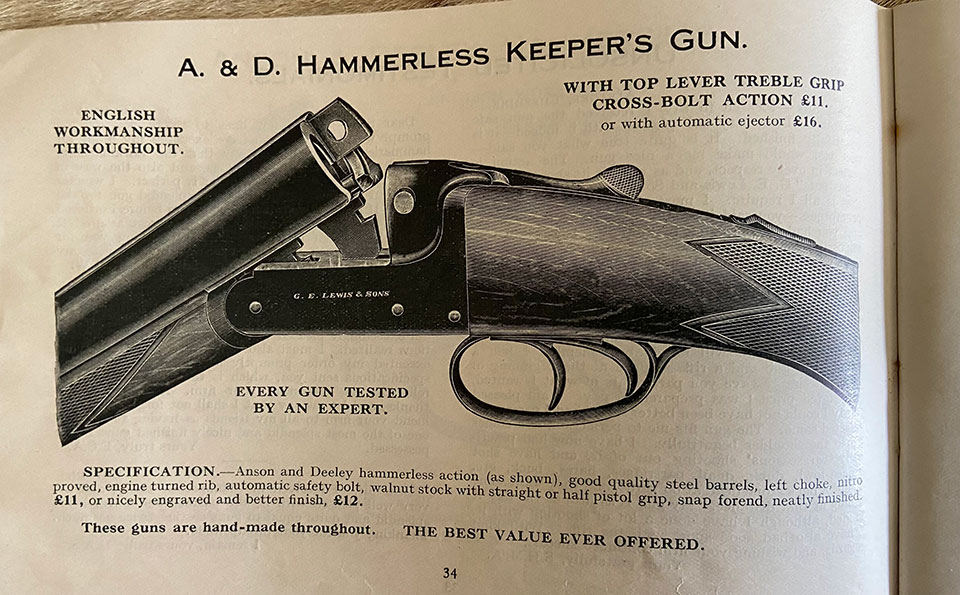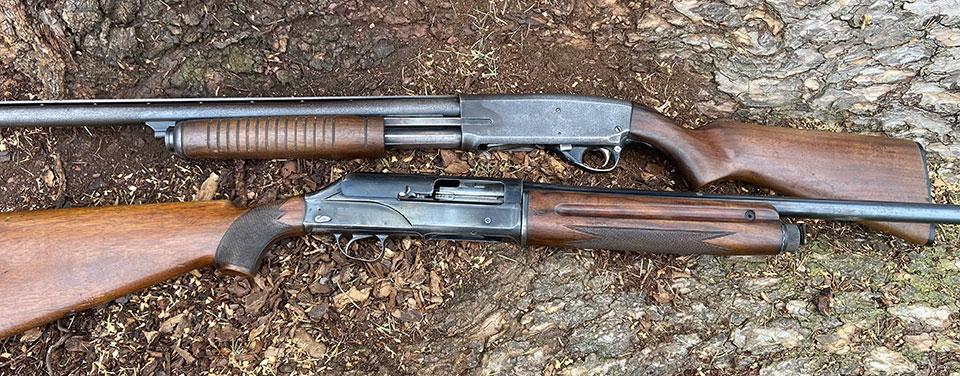The decline of many a beautiful Victorian shotgun can be traced through its ownership lineage. Ordered by the squire and used on driven pheasant days in polite company, at first.
However, the 19th century was so inventive and progress so rapid that a gun ordered in 1860 as the pinnacle of firearms development was positively old-hat five or ten years later and had to be replaced.
That lovely pin-fire shotgun would either be left in the gun room and not touched for the next hundred and fifty years or handed to to the game keeper, who would subject it to much rougher treatment than had his master.
When the next hand-me-down made it to the ‘keeper, the old one would go to the gardener, who would be harder still on the gun. Eventually, it may end up in the hands of a boy protecting an orchard.
So, the ‘keeper’s gun was not always a thing to be despised. In fact, the ‘keeper on a good estate often had a gun that was first class but just rather old-fashioned.
By 1890 this parade had slowed down a good deal because the guns being purchased by the landed gentry were pretty much what they remained for the next century. Those needing to buy a gun for their gamekeeper had to look to the offerings of Britain’s gunmakers for a suitably robust but pleasingly inexpensive option.
a gun ordered in 1860 as the pinnacle of firearms development was positively old-hat five or ten years later
Gunmakers were pleased to oblige and a ‘Keeper’s Gun’ featured in the catalogues of many retailers in London, Birmingham and the provinces.
W.R. Pape, of Newcastle, adversed a Damascus barrelled hammer gun in the 1890s, branded the ‘Keeper’s’, at £6.10.s 0d and claimed it to be ‘Undoubtedly the best value ever produced in plain guns’.
So, what is a ‘Keeper’s Gun and how does one recognise it? Generally, it will be constructed along the lines of the G.E. Lewis ’Hammerless Keeper’s Gun’ advertised in that firm’s 1930s catalogue.
Lewis describes it as; ‘Anson & Deeley, hammerless action, good quality steel barrels, left choke, nitro proved, engine turned rib, automatic safety bolt, walnut stock with straight or half-pistol grip, snap forend, neatly finished (£11.0.0) or nicely engraved and better finish (£12.0.0).’ These guns were hand-made in England, tested before dispatch and claimed to be; ’The best value ever offered’. This boast, it appears, was commonly and lightly made in the gun trade.
Keeper’s guns filled a niche; avid sportsmen who could not afford a best gun but desired something well made that could stand a lot of work also bought them. One wrote from Australia ‘You might build more expensive guns but for killing powers they won’t beat my Lewis (Keeper’s Gun)’.
They also satisfied a canny boss buying for an employee that he was getting a good value, robust tool with which his minion could do his job. One ‘Head Keeper’ wrote to Lewis in 1924; ‘I got one from you four years ago for one of my men, it is as firm as ever and a better gun I don’t wish to handle. I forget what I gave for it but it is named ‘The Keeper’s Gun’.
G&S Holloway sold two models in the late 1920s that filled the ‘Keeper’s Gun’ remit; one a hammer gun with back-locks, the other and Anson & Deeley non-ejector. Both are plainly finished with just border engraving, steel barrels, choked Cylinder and Full choke. The hammer gun cost £10 and the boxlock £17.10.0. A best side-lock ejector then cost £88.0.0, by way of comparison.
the £67.9.6 ‘Model C’ non ejector was Thomas Bland’s offering
In the 1950s, English guns were still available in a wide range of qualities and the £67.9.6 ‘Model C’ non ejector was Thomas Bland’s offering of the ‘keeper’ type, with cylinder and full-choked steel barrels, plain wood and border engraving. However, this period was the end of the road for English guns competing in the market at this level.
Bland had been openly using the name ‘Keeper’s Gun’ since the 1890s to denote a particular model produced to fill that need. He produced hammer and hammerless versions over the years.
So, the two characteristic ‘Keeper’s Guns’ we have discussed so far are the quality gun handed down from employer to employee when it looks a little dated or gets replaced by something new and the purpose made, good quality, plain gun, made to stand-up to hard work without the sears slipping or the barrels shooting loose.

A lot of beautiful, best quality, hammer guns were ruined by ‘keepers, though I’m sure many a gamekeeper was the proud wielder of a Boss or Purdey hammer gun for the majority of his career and his hard use of these bespoke and beautiful thoroughbreds proved just how well made and reliable they were and how much abuse they could stand.
When you encounter a best hammer gun with no finish, no chequer, covered in dents, scratches and repairs of questionable provenance, there is a fair bet it is one the boss gave to his ‘keeper when he bought a hammerless replacement.
The 19th century ‘keeper would carry out the majority of his vermin control by trapping. Cartridges were expensive and shooting as a solo tactic relatively inefficient, though when opportunity arose, the shotgun invariably found its target.
Of course, a 12-bore shotgun was unlikely to be the only firearm a twentieth century gamekeeper had use for and when retiring gamekeepers show me their cabinet, it usually contains a Webley bolt-action .410 for close range vermin control and a .22 bolt-action rifle for rabbits and rooks. This is usually a CZ of uncertain vintage, or possibly a Walther or Anschutz.
These Czech rifles, when they arrived in Britain in the 1950s priced at £23, were relatively inexpensive (a Walther .22 was £31), well-engineered, reliable and accurate. Soon, it seems every ‘keeper had one. The beauty of the .22 rimfire was its lack of report, when used with sub-sonic ammunition and its low cost to feed, compared with earlier centre-fire ‘rook rifles’.
the Belgian folding .410 single cost £17 and was handy and cheap
The Webley & Scott .410 cost £10 in the 1950s and was chambered for the 2 1/2” ‘Fourlong’ cartridge. It was handy, light, effective at forty yards and largely maintenance free. Another staple was the Belgian folding .410 single barrel .410, which cost £17 and was a handy and cheap companion to slide into the gap between driver and passenger seats, ready to be whipped out at a moment’s notice.
The attraction of a semi-automatic or pump-action began to take effect in the 1950s, with British dealers importing American Browning semi-autos and Italian Breda and Franchi alternatives.
This was also the era of the ‘Polychoke’, with its nine adjustments twisted by hand allowing easy alteration, from rabbits bolted by ferrets at close range, requiring no choke to a fox drive where full-choke served better. The practical ‘tool gun’ attitude of these machine-made semi autos appealed to the professional more than to the sportsman.
However, they were not especially cheap when new, with a Browning 5-shot semi-auto costing half as much as a best boxlock, or the same as a boxlock non-ejector. As they came onto the secondhand market pump-action and semi-automatics began to appear more frequently in a ‘keeper’s hands for the control of vermin.
a true ‘keeper’s gun will stand hard work and even outright neglect
The essence of a true ‘keeper’s gun is one that will stand hard work and even outright neglect, being thrown in and out of the back of a pick-up or laid on the ground, rarely cleaned and treated as a piece of agricultural equipment.
Today, the typical gamekeeper’s gun cabinet contains a decent .22 rimfire bolt-action for rabbits and squirrels, a .243 for foxes, a 12-bore Beretta Silver Pigeon and perhaps a semi-auto of some kind.

His Victorian counterpart may have been tempted to pack a pistol to deter poachers and would likely have set alarm guns around his woods to signal the presence of, and scare, intruders but those seem to have fallen out of favour.
Though today’s gunmakers offer ‘keepers some very practical options, like stainless steel rifles with plastic stocks, chrome-lined shotgun barrels and ‘Realtree’ camouflage semi-autos, I’m sure few modern ‘keepers would complain if the boss reverted to the old custom of handing him a lightly-used Purdey every decade or so, as he traded-up to the latest model.
Published by Vintage Guns Ltd on




